Overview
To successfully purchase commercial property in Australia, investors must adopt a structured approach. This involves:
- Understanding various property types
- Establishing a budget
- Conducting thorough due diligence
- Evaluating potential locations
- Navigating legal requirements
- Exploring financing options
Thorough preparation and informed decision-making are paramount for achieving successful investments. Insights into market trends, financial planning, and risk management further enhance the likelihood of a profitable acquisition. Are you ready to take the next step in your investment journey?
Introduction
In the dynamic landscape of Australian commercial real estate, grasping the diverse property types and their associated benefits is essential for investors aiming to seize lucrative opportunities. From retail and office spaces to industrial and mixed-use properties, each category offers unique advantages that can yield significant returns.
As the market evolves, factors such as sustainability trends and the increasing demand for flexible workspaces further shape investment decisions. This article explores critical aspects of commercial property investment, including:
- Budgeting strategies
- Due diligence processes
- Financing options
Equipping potential investors with the knowledge to navigate this complex terrain effectively. By examining these vital elements, investors can make informed choices that align with their financial objectives and position themselves for success in the ever-changing commercial property market.
Understanding Commercial Property: Types and Benefits
In Australia, commercial real estate is categorized into several distinct segments, each presenting unique investment opportunities:
-
Retail Spaces: This category includes shopping centers, standalone shops, and showrooms. Retail spaces are particularly appealing due to their potential for stable income, often secured through long-term leases with tenants. As consumer preferences shift towards prime locations and experiential shopping, these properties are well-positioned for growth. The increasing demand for retail areas is also driven by population growth and infrastructure development, enhancing accessibility and foot traffic. Finance Story focuses on developing customized loan proposals and refined business cases to assist you in securing funding for these ventures, leveraging our extensive network of lenders to match your specific situation.
-
Office Spaces: Ranging from single-tenant properties to large office complexes, office spaces serve as the backbone of business operations. The demand for flexible workspaces has surged, propelled by evolving work patterns, making this sector increasingly dynamic. Recent trends indicate a preference for co-working spaces, reflecting the changing needs of businesses and employees alike. With Finance Story's expertise, you can navigate funding options tailored to your specific needs in this evolving market, including access to a diverse range of lenders.
-
Industrial Properties: This segment encompasses warehouses, manufacturing facilities, and distribution centers, which are essential for logistics and supply chain management. The rise of e-commerce has intensified the demand for efficient industrial spaces, presenting lucrative financial opportunities. Additionally, job creation and infrastructure development further bolster this sector's expansion. Finance Story can assist you in refinancing your business loans to align with the evolving needs of your enterprise in this sector, ensuring you have the appropriate financing solutions in place.
-
Mixed-Use Developments: These developments integrate residential, business, and retail spaces, creating diverse income streams. Their versatility attracts a variety of tenants, making them a compelling choice for investors seeking stability and growth. The trend towards sustainable buildings also enhances the appeal of mixed-use developments, aligning with consumer preferences for environmentally friendly options. Utilizing self-managed super funds (SMSF) for these ventures can be a strategic decision, and Finance Story provides guidance on effectively employing SMSF for business real estate investments.
When considering how to buy commercial property in Australia, it's crucial to recognize the advantages of investing in business real estate, including higher rental returns compared to residential locations, longer lease durations, and significant potential for capital growth. With the Australian business real estate market projected to reach a value of approximately AUD 77.84 billion by 2034, understanding how to navigate this landscape is essential for making informed financial decisions. Recent trends indicate a growing preference for sustainable buildings and co-working spaces, further enhancing the allure of real estate investments in Australia.
Moreover, insights from the case study on trends in the Australian Commercial Real Estate Market underscore the significance of prime locations and flexible workspaces, which are critical factors driving demand in the current landscape.
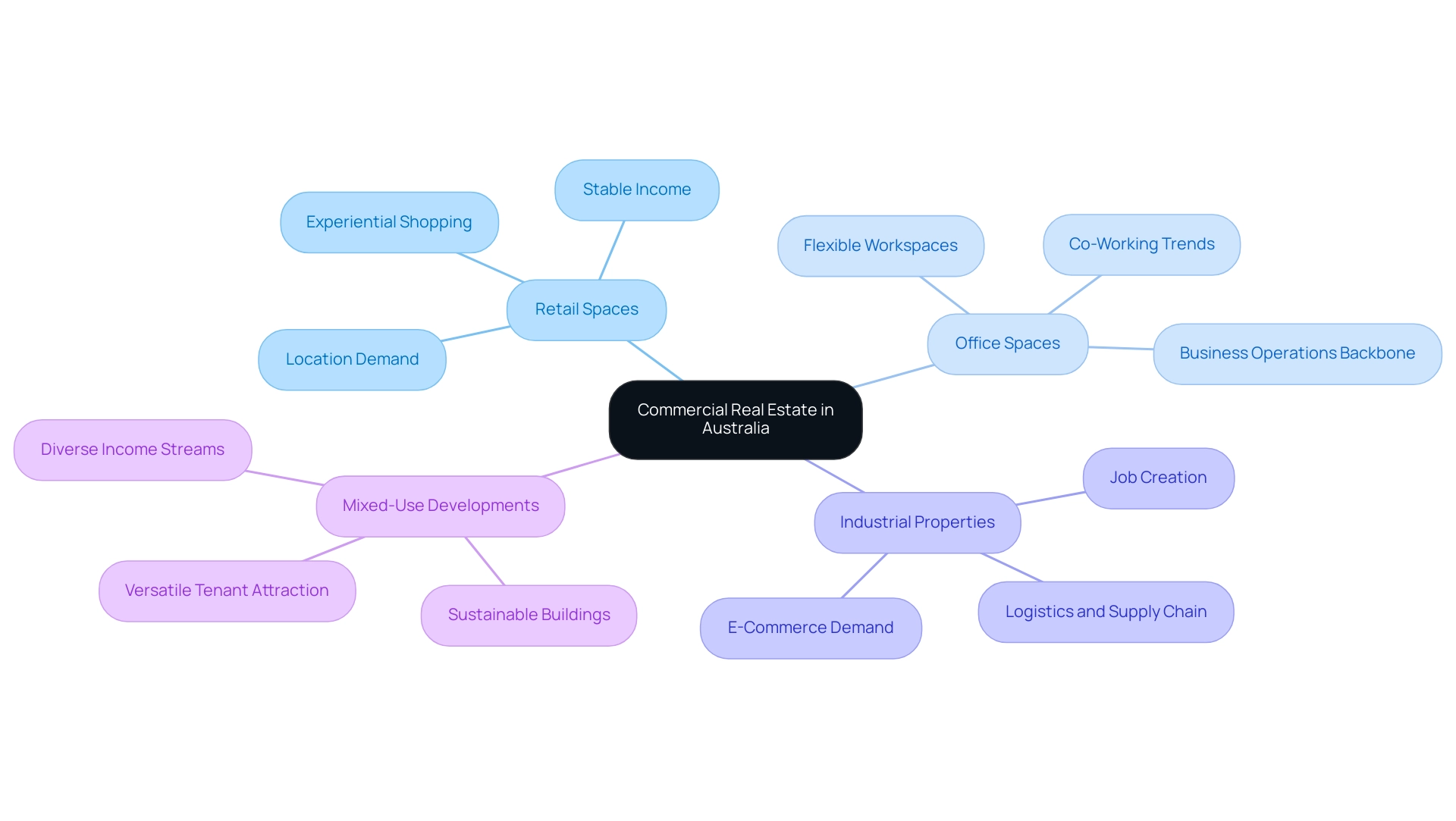
Budgeting for Your Purchase: Financial Planning Essentials
Before embarking on the journey of purchasing commercial property in Australia, it is essential to establish a comprehensive budget. This budget should encompass several key components:
- Purchase Price: Assess your financial situation to determine the maximum amount you are willing to invest in real estate. This figure will serve as the foundation for your budget when considering how to buy commercial property in Australia.
- Deposit: In Australia, a deposit typically ranges from 20% to 35% of the purchase price. A larger deposit can significantly enhance your financial position, as illustrated by the case of Mr. Davies, who experienced notable financial benefits from providing a substantial deposit when acquiring an investment asset.
- Ongoing Costs: Account for recurring expenses such as management fees, maintenance, insurance, and taxes. Given that business real estate often involves higher liability risks due to frequent public access, insurance expenses can be particularly substantial.
- Financing Costs: Include interest rates, loan fees, and other costs associated with obtaining a mortgage. As of 2025, it is crucial to closely monitor current interest rates for business real estate loans, as they can influence your overall funding strategy.
To effectively budget for a business real estate acquisition and understand how to buy commercial property in Australia, consider implementing a savings plan that includes cutting unnecessary expenses and investigating available government grants and schemes designed for first-time buyers or investors. This proactive strategy not only helps in gathering the essential deposit but also positions you advantageously in the competitive business real estate sector.
Furthermore, Finance Story's expertise in developing refined and customized business cases for banks, along with personalized loan proposals, can aid you in managing the intricacies of funding business acquisitions. Whether you are looking to acquire a warehouse, retail premise, factory, or hospitality venture, Finance Story provides access to a diverse portfolio of private lenders and mainstream financial institutions. This ensures you obtain tailored choices that enhance your service offerings and efficiency in securing the best financing solutions, including refinancing alternatives to address your changing business requirements.
Establishing a comprehensive budget will not only clarify your financial capacity but also simplify your search on how to buy commercial property in Australia, ensuring that you make informed decisions throughout the purchasing process.
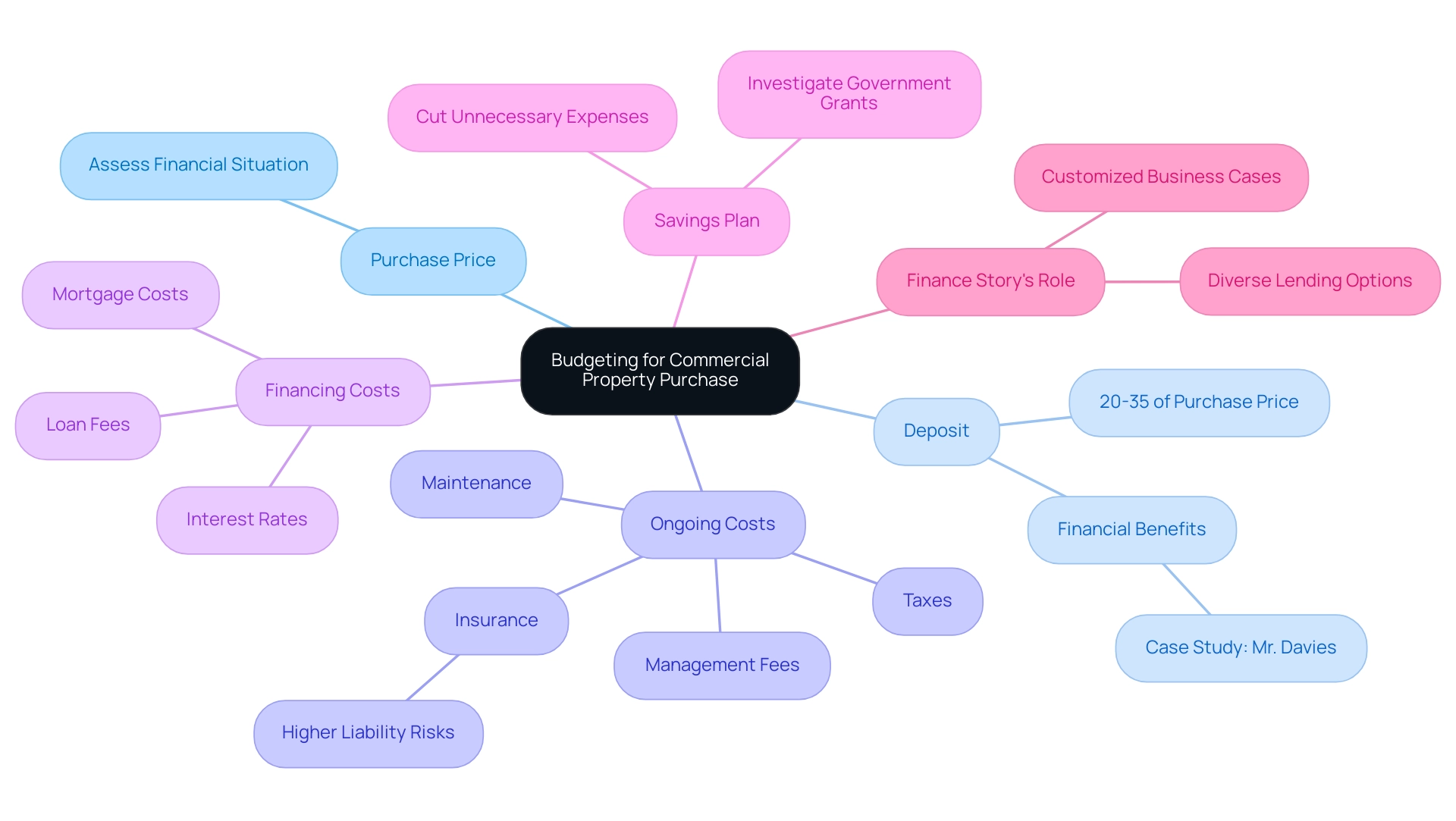
Conducting Due Diligence: Researching Your Property
Conducting due diligence is a critical process in commercial property investment, encompassing several essential steps that ensure informed decision-making:
- Property Inspection: Engaging a qualified inspector is paramount to assess the physical condition of the premises. Inspections can uncover necessary repairs or maintenance issues that, if overlooked, may lead to significant financial risks. For instance, skipping inspections can result in unexpected costs from repairs or renovations that could have been anticipated. As highlighted in case studies, thorough inspections not only safeguard investments but also identify opportunities for enhancement and value optimization, maximizing appeal to prospective tenants or buyers.
- Title Search: It is crucial to verify the title of the asset to ensure there are no liens or encumbrances that could jeopardize ownership. Statistics indicate that title searches can prevent ownership disputes, which are not uncommon in Australia’s real estate market. Ensuring a clear title is a foundational step in safeguarding your investment.
- Zoning Regulations: Checking local zoning laws is essential to confirm that the intended use of the site aligns with regulatory requirements. Understanding these regulations can prevent future legal complications and ensure that the asset can be utilized as planned.
- Financial Performance: A thorough review of the asset's financial history, including rental income, expenses, and occupancy rates, is vital. This analysis offers insights into the asset's profitability and assists in recognizing any financial warning signs that may influence funding choices.
- Market Analysis: Conducting a market analysis allows investors to gauge local market conditions, including demand, competition, and potential for appreciation. This step is crucial for understanding the broader economic landscape and making informed predictions about future real estate value.
Following these steps not only provides investors with a thorough understanding of the asset but also boosts their confidence in its potential. As Kathryn, the Pacific Communications Director at CBRE, observes, "Thorough due diligence is essential for making informed real estate decisions in today's market." Furthermore, Coakley promotes innovation in environmental ratings, highlighting the necessity for modern practices in property development.
By prioritizing these practices, investors can reduce risks and prepare themselves for secure and profitable opportunities in the real estate sector. The significance of building inspections is further emphasized by the case study titled 'Conclusion: Making Informed Property Decisions,' which illustrates how thorough inspections help ensure buyer confidence and protect assets.
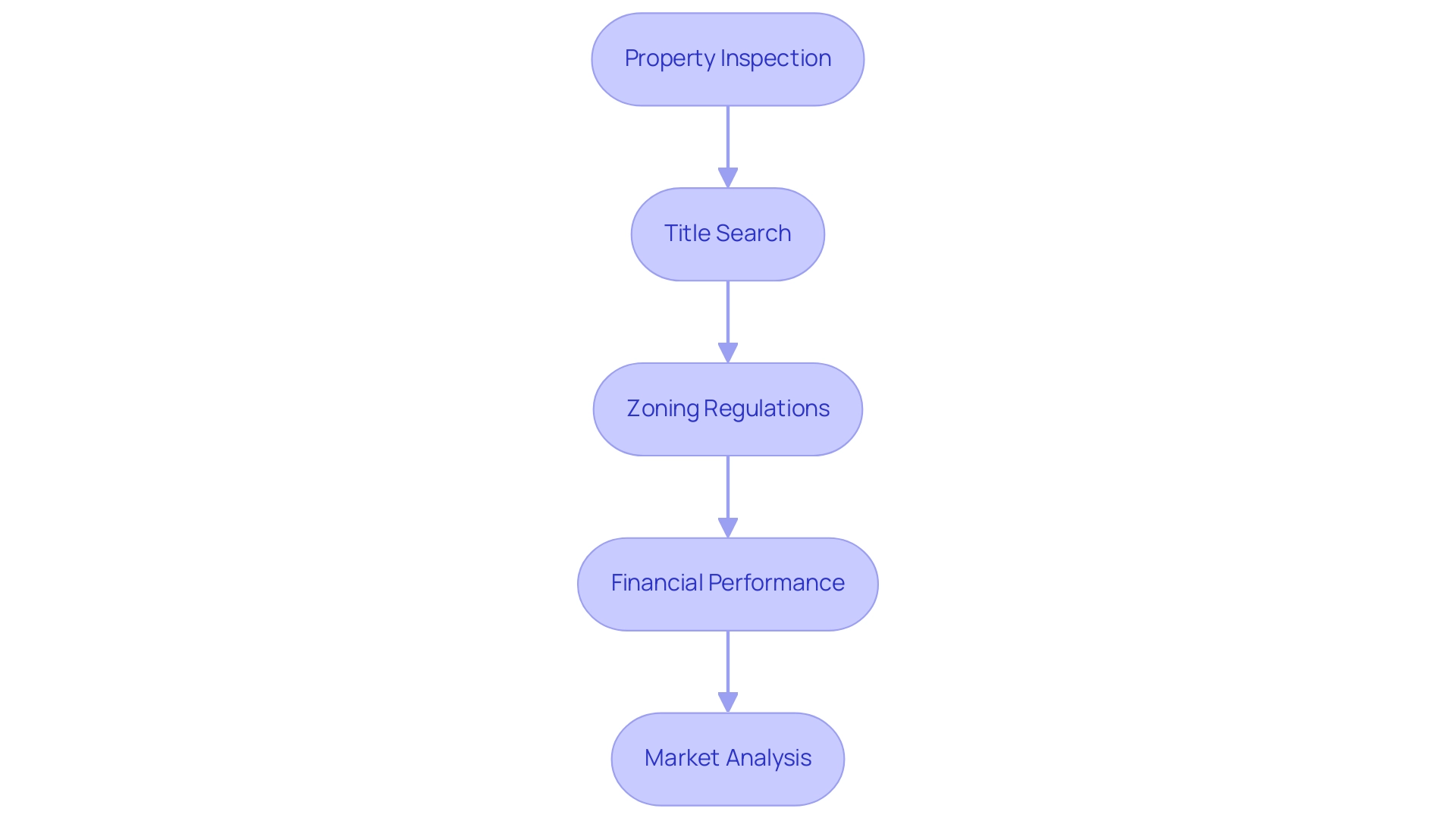
Choosing the Right Location: Evaluating Property Conditions
When assessing a site's location for business investment, several essential factors must be taken into account to ensure a successful acquisition:
-
Accessibility: A site that is easily reachable via public transport and major roadways is more likely to attract tenants. Statistics indicate that locations with high accessibility can see a tenant attraction increase of up to 30%, making this a vital consideration.
-
Surrounding Amenities: The proximity to essential services such as banks, restaurants, and public transport significantly enhances the appeal of a site. Properties located near vibrant amenities not only attract tenants but can also command higher rental rates. For example, business real estate in locations with varied amenities has demonstrated a 15% rise in values over the last five years.
-
Market Trends: Recognizing the region's economic expansion, demographic changes, and upcoming development strategies is essential. Recent trends show that smaller tenants are increasingly occupying spaces in the Sydney CBD, accounting for over 40% of new demand despite larger tenants downsizing. This shift underscores the importance of staying informed about market dynamics that can affect asset values. Furthermore, the Queensland government’s capital program, valued at $89 billion, offers substantial opportunities in business spaces, especially in regions set for expansion.
-
Impact of Education Sector Changes: The education sector in Australia is undergoing major transformations due to government measures influencing student enrollment and international student access. These changes can influence demand for business real estate in certain regions, making it crucial to understand how to buy commercial property in Australia when assessing potential investments.
-
Condition of the Asset: Evaluating the physical condition of the asset, including its structural soundness and adherence to safety regulations, is vital. Real estate that necessitates considerable repairs can discourage prospective renters and adversely affect investment yields.
-
Funding Considerations: When learning how to buy commercial property in Australia, obtaining the appropriate funding is essential for successful business real estate investments. At Finance Story, we specialize in creating polished and highly individualized business cases to present to lenders, ensuring you have access to a full suite of financing options tailored to your needs. We collaborate with a complete array of lenders, including major banks and creative private lending groups, to accommodate your situation whether you are seeking to refinance your business loan or acquire a new asset. Grasping loan frameworks, equity usage, and repayment standards can greatly influence your investment approach.
By carefully assessing these elements, you can choose a site that not only aligns with your investment objectives but also positions your business asset for long-term success in the evolving Australian market.

Navigating Legalities: Contracts and Documentation
Navigating the legalities of purchasing commercial property in Australia is essential for ensuring a successful transaction, particularly when considering funding alternatives. Key components to consider include:
-
Contract of Sale: This essential document outlines the terms of the sale, including the purchase price, deposit amount, and specific conditions. It is vital to thoroughly understand all clauses before signing, as they dictate the obligations of both parties. Comprehending how these terms connect to your funding choices can help you better prepare for the financial commitments involved.
-
Disclosure Statements: Sellers are legally required to provide disclosure statements that outline any known issues with the premises. This openness is essential in preventing future conflicts and ensuring that buyers are completely aware of the condition of the asset, which can affect the valuation and funding of the asset.
-
Leases: If the location is currently tenanted, it is important to review existing leases. Comprehending tenant obligations and rights can greatly influence your investment approach and future cash flow, which is crucial when evaluating how much equity you can utilize for funding.
-
Legal Representation: Engaging a solicitor or conveyancer who specializes in business real estate transactions is highly recommended. Their expertise will guide you through the complexities of the legal process, ensuring that your interests are protected and that you are aware of how financing structures can affect your purchase.
In 2025, prevalent legal challenges in business real estate transactions in Australia involve disagreements regarding contract conditions and adherence to local regulations. Statistics indicate that a significant percentage of contract disputes arise from misunderstandings regarding disclosure statements and lease agreements. For instance, a recent report highlighted that many buyers faced challenges due to inadequate knowledge of their rights and obligations under existing leases.
Moreover, case studies reveal that successful contract negotiations often hinge on clear communication and thorough due diligence. Legal professionals emphasize the importance of understanding contracts of sale and disclosure statements, which are crucial for anyone learning how to buy commercial property in Australia, as these documents form the foundation of any commercial property transaction. By proactively addressing these legal aspects and considering funding options, buyers can improve their understanding of how to buy commercial property in Australia, thereby mitigating risks and enhancing their chances of a successful purchase.
Given the current housing affordability crisis, which may reduce the number of buyers and impact conveyancing matters, it is essential for small business owners to be well-informed about their financing options. Furthermore, the recent amendment approved on November 29, 2024, seeks to update Australia's AML/CTF framework, offering legal professionals opportunities to improve compliance strategies pertinent to business transactions. Incorporating insights from legal experts can further clarify the importance of these documents.
As Tim Coy, a senior research leader in real estate, notes, "Understanding the nuances of contracts of sale and disclosure statements is vital for any buyer looking to navigate the complexities of business transactions."
Furthermore, the growing emphasis on sustainability and energy efficiency in real estate cannot be overlooked. As emphasized in a recent case study, many purchasers are preparing to carry out extensive energy retrofits due to rising regulatory standards, making it essential for small business owners to contemplate these factors in their financial choices, alongside their funding strategies.
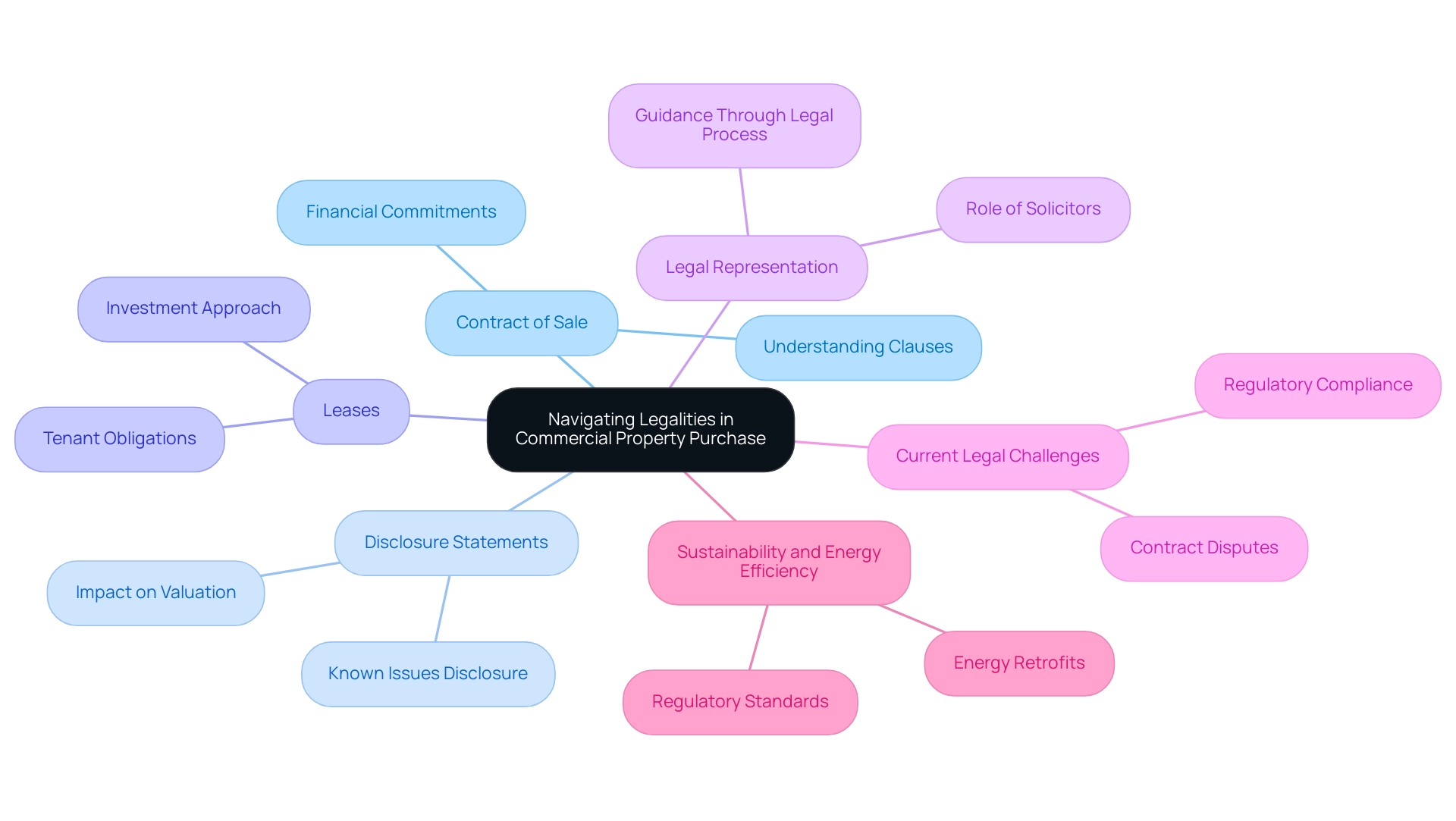
Financing Your Purchase: Exploring Loan Options
When funding your business real estate acquisition in Australia, it is crucial to investigate various loan alternatives to identify the best match for your financial circumstances and investment objectives.
Traditional Bank Loans: These loans are a popular option for many investors, generally necessitating a significant deposit of approximately 30% or more. They often come with competitive interest rates, making them an attractive option for those who can meet the stringent lending criteria set by banks. However, recent regulatory changes, such as the increase in the minimum residential mortgage serviceability buffer from 2.5% to 3% by APRA, have made it crucial for borrowers to demonstrate robust financial health. This rise indicates that borrowers must now demonstrate they can handle higher repayments, which could restrict access to funding for some.
Alternative Lenders: Non-bank lenders are gaining popularity in the business finance landscape, providing more flexible terms and faster approval processes. While these loans may come with higher interest rates, they can be a viable solution for borrowers who may not meet the strict requirements of traditional banks. The growing investor demand for private debt, particularly from institutional investors like pension funds, is creating new funding opportunities in this sector. As noted by Development Finance Partners (DFP), 'Investor Demand for Private Debt – Institutional investors, including pension funds and insurance companies, are pouring money into non-bank real estate debt, creating new funding opportunities, which is crucial for understanding how to buy commercial property in Australia, especially through business real estate loans that are specifically designed for acquiring business real estate and frequently have terms that vary considerably from residential loans. They are created to suit the distinct cash flow and risk profiles linked to business real estate endeavors, making them a favored option for numerous investors. Finance Story focuses on developing refined and uniquely tailored business cases to present to lenders, guaranteeing you obtain the appropriate funding for your business premises.
SMSF Loans: For individuals with a Self-Managed Super Fund (SMSF), using these resources to acquire business real estate can offer considerable tax advantages. This option allows investors to leverage their superannuation savings while also diversifying their portfolio. Finance Story provides expert advice on navigating SMSF real estate ventures, ensuring customized lending solutions that align with your financial objectives.
As the real estate market evolves, especially in 2025, it is essential to understand how to buy commercial property in Australia and the nuances of these financing options. The anticipated decline in interest rates and strong population growth are expected to bolster lending volumes and asset prices, making business real estate a stable investment choice amidst global economic uncertainties. Moreover, as emphasized in the case study 'Investor Sentiment and Market Dynamics in 2025,' the market is likely to experience a rebound in asset prices, with strong investor appetite for real estate debt.
Evaluating each option carefully will empower you to make informed decisions that align with your financial aspirations. It is also important to note that policymakers and regulators need to monitor non-bank lending developments due to potential risks to financial stability, including the amplification of credit cycles and weakened lending standards by banks.
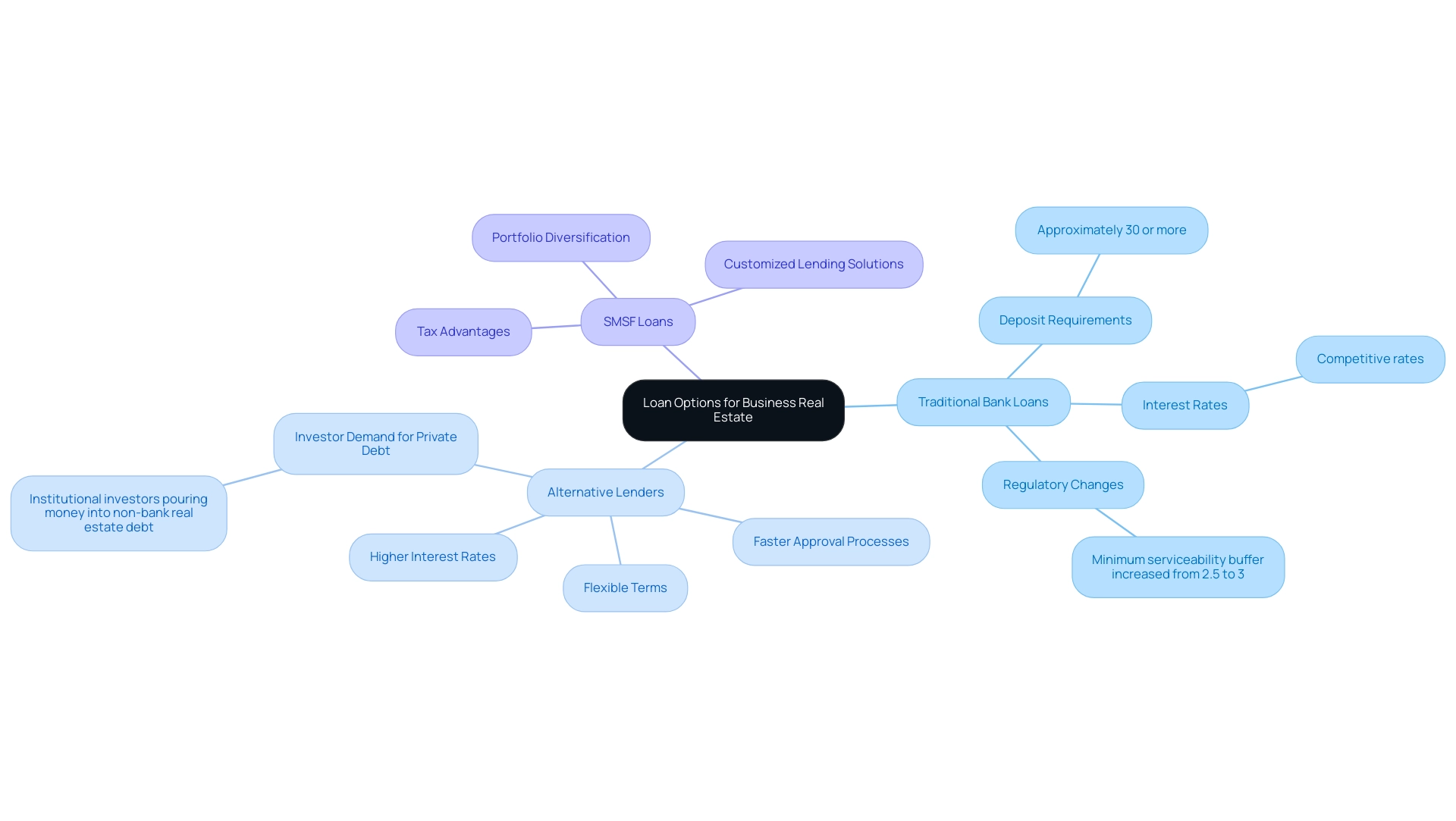
Recognizing Risks: What to Watch Out For
Investing in commercial property presents several inherent risks that potential investors must carefully consider:
-
Market Fluctuations: Economic downturns can lead to decreased demand for commercial spaces, resulting in lower rental income. Recent trends indicate that while total returns across industrial assets have declined, market sentiment suggests that the sector may be stabilizing, with expectations that the most significant corrections are likely behind us. Dr. Brendan Rynne, Partner and Chief Economist at KPMG, observes, "Despite total returns across all industrial assets declining over the past 12 months to March 2024, market sentiment indicates that the sector is reaching its lowest point."
-
Vacancy Rates: High vacancy rates can severely impact cash flow and profitability. As of 2025, understanding how to buy commercial property in Australia will be crucial, as average vacancy rates for commercial spaces are projected to remain a concern, particularly in areas with oversupply or declining demand. This statistic is vital for investors to consider when assessing potential assets.
-
Regulatory Changes: Shifts in zoning laws or real estate regulations can significantly affect usage and value. Investors must remain aware of possible legislative changes that could impact their assets.
-
Environmental Risks: Properties may face environmental challenges that necessitate costly remediation efforts. Conducting environmental assessments prior to understanding how to buy commercial property in Australia can help identify potential liabilities.
To effectively mitigate these risks, investors should:
- Conduct Thorough Due Diligence on how to buy commercial property in Australia: Research the local market, asset history, and economic indicators to make informed decisions. Partnering with experts like Finance Story can enhance your understanding of tailored financing solutions that align with your investment goals.
- Maintain a Diversified Portfolio: Diversification across various asset types and locations can reduce exposure to market volatility.
- Stay Informed About Market Trends: Regularly review market reports and analyses to anticipate fluctuations and adjust strategies accordingly.
A case study on tenant demand emphasizes how migration affects the business real estate landscape. New migrants to Australia require housing before seeking business spaces, which increases pressure on the residential market. This dynamic can lead to a larger tenant pool for residential units, potentially resulting in higher rental income due to increased competition, while business spaces may experience limited demand.
This highlights the significance of understanding market dynamics when investing in real estate.
By understanding these risks and implementing strategic measures, including learning how to buy commercial property in Australia through self-managed super funds (SMSF), investors can navigate the complexities of real estate investment more effectively.
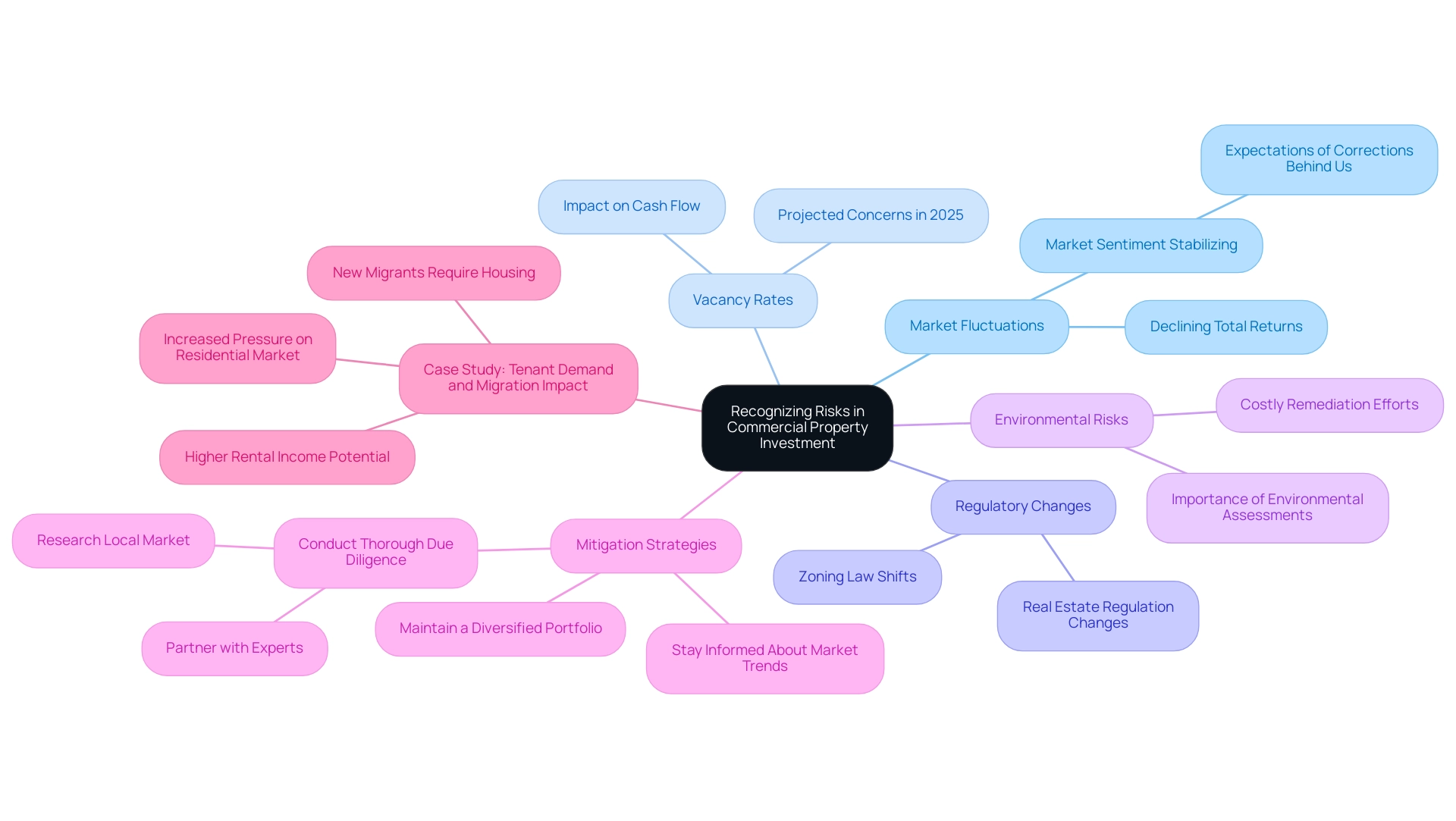
Final Tips for a Successful Purchase: Preparing for Ownership
To ensure a successful acquisition and ownership experience in business real estate, consider the following essential tips:
-
Management: Determine whether you will oversee the asset yourself or hire a professional manager. Effective management of real estate is crucial, as it directly influences tenant satisfaction and retention. In Australia, the CBD office management sector is the largest segment of commercial asset management and has shown resilience, recovering from pandemic lows. This highlights the importance of skilled management in navigating market fluctuations. Managers are encouraged to prioritize work-life balance and invest in professional development to enhance their effectiveness.
-
Regular Maintenance: Establish a proactive maintenance schedule to keep the assets in optimal condition. Regular maintenance not only preserves the value of your investment but also enhances tenant satisfaction. Studies indicate that assets with consistent upkeep experience higher tenant retention rates, which is vital in a competitive market.
-
Financial Monitoring: Diligently track income and expenses to ensure the asset remains profitable. To effectively budget and avoid unexpected financial strain, it's important to understand how to buy commercial property in Australia, including the average maintenance costs projected to be around 2-3% of the property value annually in 2025. Additionally, when considering funding options, it's essential to work with experts like Finance Story, who specialize in creating tailored loan proposals that meet your specific needs. Finance Story provides access to a complete variety of lenders, including high street banks and innovative private lending panels, ensuring you discover the appropriate funding solution. This expertise can assist you in navigating the complexities of loan repayment requirements and securing the appropriate funding for your venture, while also providing guidance on how to buy commercial property in Australia, whether you are acquiring a warehouse, retail space, factory, or hospitality business.
-
Stay Informed: Keep updated on market trends and regulatory changes that may affect your real estate. Engaging with industry professionals can provide valuable insights. For instance, Nigel Virgo, National Sector Leader at KPMG, emphasizes the importance of navigating the current business environment and planning for future developments. Property management experts also stress the need for continuous professional development and collaboration to adapt to evolving market conditions.
By implementing these strategies and leveraging the expertise of Finance Story in securing tailored financing solutions, including refinancing options, you can significantly enhance your investment's performance and ensure a smooth ownership experience, ultimately leading to long-term success in the commercial property landscape.

Conclusion
Understanding the intricacies of commercial property investment in Australia is crucial for anyone looking to navigate this complex market successfully. The exploration of various property types—retail, office, industrial, and mixed-use—reveals unique benefits within each category, from stable income streams to diversification of investment portfolios. Furthermore, the importance of thorough budgeting and due diligence cannot be overstated; these foundational steps mitigate risks and ensure informed decision-making.
Equally vital is the consideration of financing options. Traditional bank loans, alternative lenders, and SMSF loans each present distinct advantages tailored to different investor needs. By understanding the nuances of these financing avenues, potential investors can secure funding that aligns with their financial objectives. Additionally, recognizing the various risks associated with market fluctuations, vacancy rates, and regulatory changes equips investors with the knowledge to navigate potential pitfalls effectively.
In conclusion, successful investment in commercial real estate requires a proactive approach that encompasses comprehensive research, strategic financial planning, and ongoing market awareness. By leveraging expert guidance and implementing best practices in property management and maintenance, investors can position themselves for sustainable growth and profitability in the ever-evolving landscape of Australian commercial property. The potential for significant returns is within reach for those who are well-prepared and informed, making now an opportune time to engage with this lucrative market.

